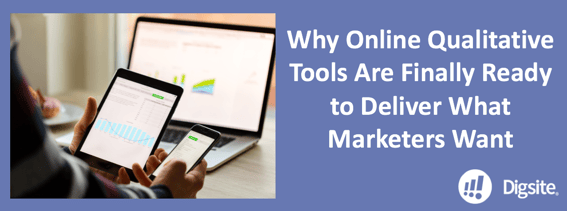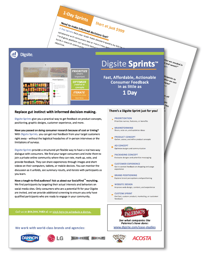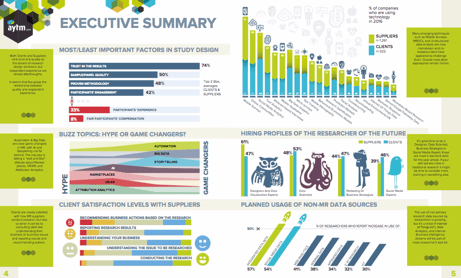
I recently spoke with a marketer about a new product launch, and it was clear that their daily decisions about features, positioning, packaging were not derived from a set of statistics, but a detailed persona of their target customer which they had built over time.
While they had previously relied on their ad agency to create personas using via focus groups and in-person research, 2016 was the year they started building upon these consumer personas while making decisions, using online qualitative tools.
Want to see an example of online qualitative in action? Check out our Dannon case study »
Why now? Tools for online surveys, focus groups, and communities have all been available for over 15 years. While online surveys quickly overtook their phone and in-person counterparts; qualitative methods like online focus groups had a much slower adoption curve. But per the latest Greenbook GRIT report, that is starting to change. They see new online tools, available on computers, smartphones, and tablets, as finally creating significant disruption in the qualitative space.
No longer are marketers feeling the need to always go to a focus group or an in-person interview to inform product or communication development. They don’t have to spend weeks planning in-person research and dealing with the logistics of getting the team together at the same time to view the research. Not to mention, marketers don’t have to spend tens of thousands of dollars to answer those challenging “why” questions.
Below I discuss four key barriers to using online qualitative research that are being addressed by newer technologies, new approaches for decision-making, and shifts in consumer behavior. I also talk about how online qualitative strengthens the impact that marketers can make for their organizations, and I share some specific tools you may want to bring to your teams in 2017 to improve your agility, get farther with your budgets, and most importantly, make better decisions.
New tools have eliminated the barriers to using online qualitative
Barrier #1: Complexity in set-up and management
THEN: It used to be you needed to hire a research consultant to conduct online qualitative. And if you were a researcher, you had to learn complex tools to set-up and manage your research study. In the end, you were stuck with hundreds of pages of text to analyze.
NOW: Tools like Digsite allow you to setup and launch a study quickly, using proven templates, automated recruiting and participation management. And visual activities and reporting significantly reduce text analysis.
Barrier #2: Cost of online vs. in person
THEN: It used to be there was no savings to conducting an online focus group or community vs. competing in-person research. In fact, online qualitative often cost more, with the only potential savings being travel expenses.
NOW: Entire online projects with multiple consumer touch points can be completed for a few thousand dollars, a fraction of the cost of traditional in-person research. And the ability to observe in real-time no longer requires expensive video technology.
Barrier #3: Teams were used to focus groups
THEN: Marketers knew what to expect in a focus group. They could probe and follow up, truly digging into the whys. Most online tools were text based, making it hard sometimes to understand the real meaning of what was being said.
NOW: Marketers are used to engaging with consumers on social media. They know the raw honesty consumer portray online. And tools like video, photos, concept mark-up and voting have made online qualitative more engaging. And, they can find the right people online, which can be a struggle to recruit in-person.
Barrier #4: Time to complete surveys vs. online qualitative
THEN: Surveys could be launched in a few days, but focus groups and communities took weeks of planning and recruiting time.
NOW: Both online surveys and online qualitative tools can be completed in real-time, with results in days rather than weeks.
Marketers need for Iterative Insights is driving online qualitative growth
As I discussed in a recent blog on Iterative Insights, marketers are being tasked with going to market much more quickly than in the past. Succeeding isn’t simply about conducting research faster, it's about using consumers to help shape branding and new products, in real time, as they are being developed.
While surveys get faster results, online qualitative tools today can get teams fast results with the added benefit of asking why, or even having consumers show you what they mean through photos and video. Iterative tools let consumers shape the outcome by sharing pain points, building ideal solutions, voting on solutions and suggesting improvements.
To get this quality of responses, a broadly recruited survey participant is not sufficient, and neither is a $1 incentive. Many online qualitative tools are designed to micro-target your specific audience using behaviors like preferred brands, products purchased or groups joined to find just the person marketers need to talk to. And they offer incentives of $10 or more, often through integrations with electronic rewards platforms that are instant and drive participant engagement.
What tools should you consider in 2017
Here are a few of the top contenders I’ve found. I would love to hear what tools you are using as we develop a more comprehensive Online Qualitative tools guide.
User Testing: Want to watch consumers as they use web applications. For $99 per person, you can collect up to 15 minutes worth of video. And they claim about 80% of responses come in within 2 hours.
Discuss I.O.: Want to talk in real-time to customers to get their opinions? Discuss I.O. can recruit in 24-48 hours and schedule video interviews around the globe to gather insights in a few days.
Digsite: Want to iterate with consumers as you build products, packages, advertisements, or websites? Digsite Sprints allow you to engage and iterate with consumers with group or private discussions, image mark-up, voting, and open/closed ended questions. Get answers in less than a week for a fraction of the cost of focus groups.
To learn more about how your company can benefit from qualitative insights, check out our Digsite Sprints Fact Sheet!






